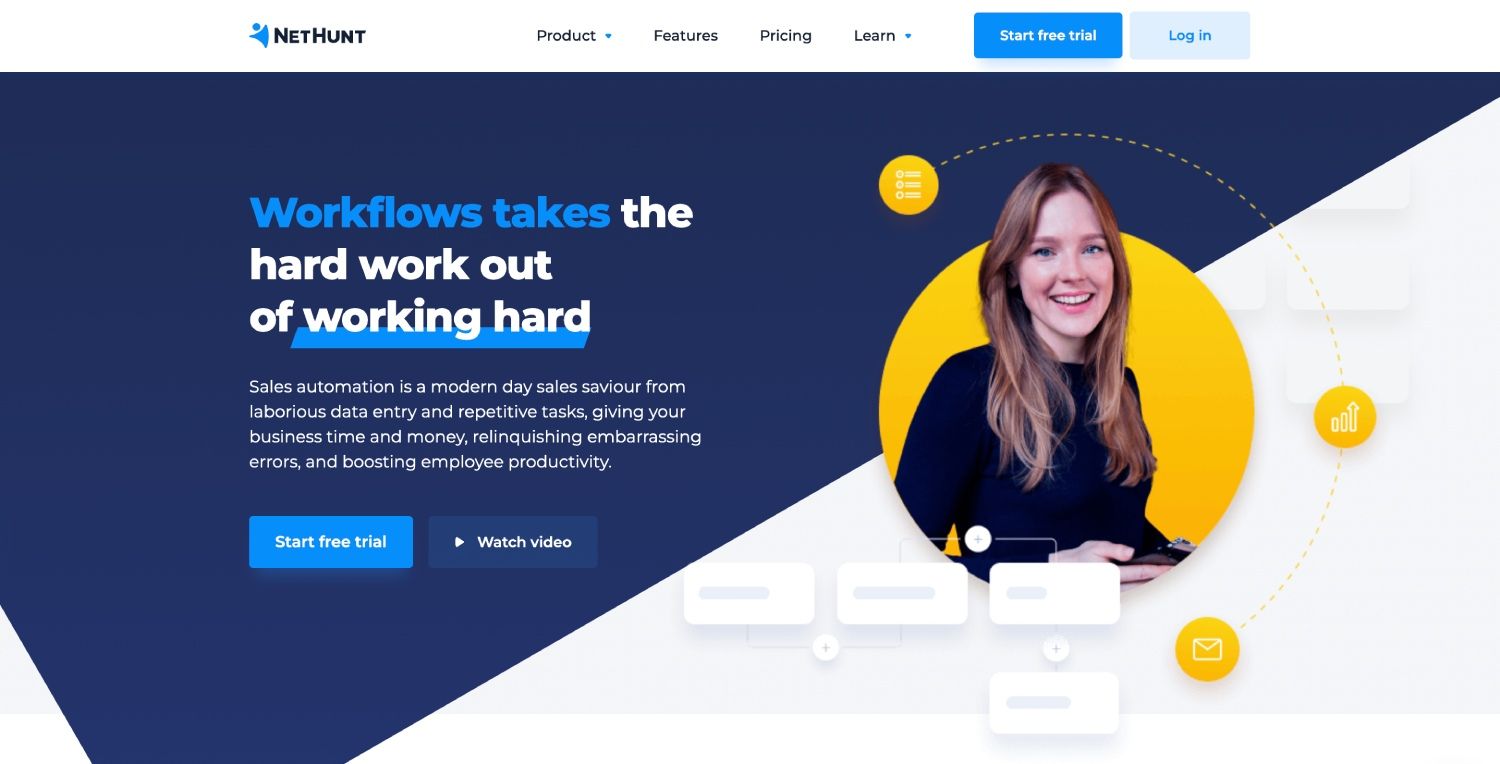Creating a sales strategy which is tailored to your customers requires an in-depth understanding of your customer's motivations. It’s no secret to most salespeople that if you can understand your customer's motives and desires, it’s significantly easier to win the deal.
This article covers dominant buyer motives every salesperson will encounter during work.
Knowing these will help you create better pitches, build rapport, and generally create a sales strategy that suits specific customers better.
What are buyer motivations?
Buyer motivation is a sales concept that refers to the psychological factors influencing customers’ purchasing of your product or service.
An understanding of what your buyers are motivated by when looking to purchase your product puts you in a better position during the sales process.
These motivations are a reflection of your buyer's needs. However, they aren’t always rational. Sometimes, prospects show emotional buying motivation, buying a product purely due to the emotions it makes them feel.
Why is it important to know your buyer's motivations?
Knowing your buyer's motivations makes it significantly easier to accompany them and provide for their needs throughout the customer journey.
If you know your buyer's motivation, you can also use them to your advantage when planning marketing campaigns.
For example, suppose your buyers’ motivations tend to be financially driven. In that case, marketing campaigns could mention case studies where the usage of your product resulted in financial gains for customers.
The other benefits of knowing a buyer's motivations are…
- Better craft offers to entice more customers to purchase your products
- Better understand what social proof to use during the sales process
- An understanding of what to focus on during product demos
- Additional knowledge than can be used to develop a better buyer persona
- More relatable marketing campaigns towards the needs and challenges of your buyers
8 buyer motives every salesperson needs to know
Although a buyer’s motivations can differ wildly from prospect to prospect, there are some encountered more often than others. It’s these buyer motivations that we believe every salesperson needs to know in order to sell more effectively.
The motivations we have listed in this article pretty much cover all the available options, from more rational ones to ones that are emotionally motivated.
So, let’s get to the eight buyer motives that every salesperson needs to know…
Fear Of Missing Out (FOMO) based buyer motives
This is a big one in the sales industry. Sometimes a prospect will look towards purchasing a product because everyone else seems to have invested in something similar.
Fear of missing out, also known as FOMO, is the fear that if you don't purchase a product you will be left out of a specific experience or an industry standard.
Although not entirely irrational, FOMO-driven decisions are very emotional. Hence, they need to be worked on with utmost care.
If a buyer starts thinking they’re not missing out on anything important or that your product is a gimmick, they will not pursue the purchase any further.
For example…
When a prospect sees that all of their colleagues in the industry have invested in a CRM system, they are naturally inclined to develop a desire to do the same. After all, if everyone is doing something, they must be doing it for a reason, right?
The prospect develops anxiety over the absence of a CRM system in their company, leading them to consider purchasing one.
As a salesperson, you need to show a buyer looking to make a FOMO purchase that they will miss out on something if they don’t purchase your product. Try focusing more on how your product benefits people in your prospect's industry.
Here’s how you can sell to customers ruled by FOMO…
- Provide social proof, like reviews and testimonials
- Show the total number of users utilising your product
- Highlight missed opportunities
- Highlight the scarcity of the offer
- Put a time limit on your offer

The key is building into the feeling of needing to purchase your product.
You can also do this by altering your messaging. When trying to convert a lead with strong FOMO, ensure you adopt the FOMO language in your pitch; the words and phrases that push them to take action instantaneously:
- “Members only”
- “Only available for registered users”
- “Special offer for subscribers”
- “Exclusive content”
- “Limited time only”
- “User-favourite”
- “Only today”
- “Don’t miss out”
- “Unique”
- “Secret”
Here’s what your pitch could look like when talking to a FOMO-ruled lead…
💬 “I understand that it’s quite a big decision to make, but hear me out. Thanks to [feature 1] and [feature 2], [your product] is a great tool to [achieve their goal]. Now think where your business will be in X months from now if you don’t [achieve their goal]?”
💬 “I don’t want you to miss out on an opportunity to remain a competitive business. Your competitors X, Y, and Z have already invested in the [product], which means they’ll be able to solve [problem] and [problem]. In the long run, it’ll help them achieve [a goal]. What about you?"
Need-based buyer motives
When the laptop you use for work breaks down, you buy a new one as soon as possible because it's something you need to continue working. The same principle applies to a good percentage of your buyers as well.
As a business grows and develops, there are bound to be more processes required to keep it sustainable. A business develops a need for certain products to aid with these processes.
For example…
A growing business needs a CRM system to scale effectively. However, your prospects won’t know just how much they need your product and, therefore, will not make the decision to purchase.
To sell to need-driven buyers, you need to…
- Highlight the necessity of purchasing your product
- Get a better understanding of what processes in the buyers' workflow require your product, and build on those more during product demonstrations
- Use value-based selling to full advantage. Make your prospect see the immediate value of purchasing your product
- Determine your customer’s pain points and build upon them in the pitch
- Utilise the prospect’s LinkedIn posts and comments to try and find milestones or challenges to mention during the pitch

An excellent example of a pitch to need-driven buyers is…
💬 “Hey [name]! Congratulations on your company’s growth over the past few years! I saw that you are having problems with [achieving a goal]. Have you ever considered implementing [product]? [product] is a [product description] that will help you [achieve a goal], with features like…
Let’s agree on a date and time to have a call so I can show you how [product] would be perfect for you.”
Risk-management-based buyer motives
Just as much as a company often looks to buy a product to help them achieve something, they also look towards buying products that ensure certain things don’t happen.
For example, a business might be investing in accounting software to ensure smooth financial operations and no gaps in the balance sheet.
Risk-management-driven purchasing decisions are often made in response to the company's growth or to the world's current challenges.
For example…
During the COVID-19 pandemic, where many businesses had to invest in remote-work solutions to adapt to the climate in the industry.
To sell to buyers motivated by risk management…
Highlight how your product helps buyers mitigate the risks they’re worried about. It’s also wise to emphasise that time is of the essence, as the longer the sale process goes on, the higher the chances the prospect’s company will encounter the challenges they’re worried about.
A good way to reach out to these types of buyers is…
💬 “Hey [name], nice to e-meet you. I saw your post about being worried about [potential problem]. Previous clients of ours [client company] have also had a similar problem: they used our product to avoid [problem].
Let’s book a call so I can tell you about it. What time are you free?”
Quality-of-life-based buyer motives
Sometimes, a purchase is just motivated by the desire to increase the quality of life, or in the case of B2B commerce, the quality of work for your buyers. It’s just like that coffee machine you bought for your home the other day. You don’t need it, but it makes life a lot easier than without it.
Quality-of-life-motivated decisions are an emotional buying motive. The thought of making work more enjoyable is no stranger to anyone.
When you feel like your buyer is initiating the purchase of your product to increase their quality of life, you should try and play on precisely those features that your product provides.
For example, you could tell your buyer…
💬 “[Process 1] and [process 2] are incredible time and energy burners, we know. With [product]’s [process 1&2 related] functionality, these tedious processes will only take a couple of clicks to complete.”
The goal is to get them thinking “wow, this will make my work more pleasant”.

Some other steps to dealing with quality-of-life-driven buyers are…
- Focus on how your product simplifies existing processes rather than which new ones it adds
- Emphasise the hassle-free nature of the usage of your product
- Create a compelling demonstration script to highlight the features of your product that improve effectiveness
- Build comparisons between the product your prospect uses and your product
Impulse-based buyer motives
Everyone knows what an impulse-driven decision looks like. Little thought was given about utility. The decision was made in the moment, with little-to-no consideration for the consequences of the purchase.
This buyer motive is tricky because there's barely any ground to stand on as you try to make your pitch. In this case, your buyer’s motives are backed by nothing but their own emotions, and emotions are a very ambiguous topic to build a sale on.
Let’s imagine the following scenario…
A prospect stumbles upon your product online. In a haze of emotion, they immediately sign up to receive a message from your sales representative.
What you should do when selling to impulse-motivated buyers is…
- Offer a discount to resonate with the impulse of buying
- Focus on emotions in the pitch to build on the impulse of your customers
- Incentivize FOMO, and present your offer with accompanying messaging to add time-based pressure to the customer
To sell to impulsive buyers, try building your pitch like this…
💬 “Hey [name]! Thanks for your interest in [product]! Let’s book a call ASAP to get you set up to start making use of [feature 1], [feature 2], [feature 3], and the rest of [product]’s features. You might also be qualified for a [discount/ promotion], I’ll be glad to tell you more about that during our call!”
Prestige-based buyer motives
Sometimes, just the fact you own a product, or that you own a specific branded product is enough to make you happy. Like a luxury branded handbag or a top-shelf home appliance.
Prestige-driven buying motives are exactly why luxury segment salespeople might refer to their product as “a status symbol”. These purchases are made mainly for the status associated with the product or the brand.
The best example of a prestige product is…
A luxury clothing brand. With most luxury clothing brands, people purchase because of the status implied by the ownership of the product.
To sell to customers looking to buy your product out of prestige, you need to…
- Build up the feeling of prestige in purchasing your product; use words like “exclusive”, “famous”, and “renowned”
- Utilise social proof in your sales pitch. Testimonies from big clients in the industry, case studies with significant companies using your product
- Provide superior service to your prospects during calls and demonstrations; a prestigious product should come with prestigious service
A good pitch to prestige-motivated buyers is…
💬 “Thank you for your interest in [product]! At [company], we believe in [company goals], and we appreciate your interest in joining our family of customers, among which we have names such as [list big clients]. Let’s book a call and proceed further.”
⚠️ ️Social proof is significant during a prestige-based sale, so use it to its full advantage.

Financial-based buyer motives
We’ve all been there, buying an off-brand product because it’s the most financially sound decision to make. Businesses work similarly. Sometimes, the decision-maker is constrained by the funds allocated by the company.
The financially-based buyer motivation requires a financially-focused sales approach to win the deal.
For example…
A company is facing a downturn due to the ongoing recession, meaning it can only operate with limited funds. The purchase of your product, just like any new product, will be considered very high risk due to the financial strain on the company.
To sell to financially-motivated buyers…
- Spend a little more time during the pitch talking about the value your product offers for its price
- Discounts and bundle deals are great to offer these kinds of customers because they create additional security on the financial side of the purchase
- Offer your customers different payment plans, bundles, and options
- Emphasise the price of your product; create an understanding of what every dollar they pay helps them achieve
➡️ Check out our article on how to handle price sales objections to get 27 free rebuttal templates.
Time-based buyer motives
This buyer motive is centred around time constraints.
The purchase might save time. Maybe it needs to be delivered and implemented under tight deadlines.
To sell to a time-motivated buyer, try building your pitch like this…
💬 “[Your product] could significantly lower the time spent on [lead’s process] by the X team, leaving them with the ability to complete more tasks during their daily work hours. It has [feature], meaning you [time-related benefit].”
Time-based purchasing motives are worked with by showing your customers how to streamline their processes, how much more time you will save them, and how fast your product can be implemented.
A couple more things you can do to appeal to time-motivated buyers include…
- During your demonstration, focus on the efficiency of your product rather than the features
- Show the client how much time implementing your product will save them
How to find your customer’s buying motives
There are a few steps to discovering your customers’ buying motives. These steps aren’t complex. However, they only provide you with an approximate benchmark to start your research.
They are…
- Determine whether your customer base is B2C or B2B
- Look at what messaging is used by your competitors
As mentioned above, these steps won’t help you attain a deep understanding of your buyers’ motivations for purchase.
To understand your customers' buying motives better, these are the next steps to take…
- Prepare for discovery calls with due diligence, ask questions that make it easier for you to identify buying motives
- Refer to your buyer persona to get a better understanding of what buyer profiles your company deals with
- Check notes of existing customers in the sales CRM to see what objections they presented and what questions they asked. Find patterns throughout your base
- Create custom tags in your CRM’s customer records to segment the database
After applying these steps to your customers, you should use the information gained about them to develop relationships with them further. You can further develop your buyer personas, which help you sell and market your content on a higher level of personalisation.
Table of Contents
Crack the sales formula with CRM Lab
Twice a month, receive actionable CRM content to your inbox.



